
Introduction:
The entry level processor market is an interesting place. They’re not quite as entry level as they used to be. AMD’s marketing strategy lately has been to undercut Intel in the mainstream processor market. As a result of this, the overall quality of “budget” CPU’s has increased. While they still may not be powerful enough to keep up with some of the latest Fermi or 5000 series graphics cards, they are more than adequate for HTPC setups or light gaming. Today we take a look at two of AMD’s new entry level processors, running on the new Regor core, the Athlon II x2 260 and 255.

Whenever we get a new processor in the lab, we like to put it through our battery of tests to check stock performance and then we like to test the overclocking capability. Let’s take a look at the benchmarks …… after taking a closer look at the chip itself.
A Closer Look:
| 260 | 255 | |
| Brand | AMD | AMD |
| Series | Athlon II X2 | Athlon II X2 |
| Model | ADX260OCGMBOX | ADX255OCGQBOX |
| Socket | AM3 | AM3 |
| Core | Regor | Regor |
| Multi-Core | Dual-Core | Dual-Core |
| Operating Frequency | 3.2GHz | 3.1GHz |
| Hyper Transports | 4000MHz | 4000MHz |
| L1 Cache | 2 x 128KB | 2 x 128KB |
| L2 Cache | 2 x 1MB | 2 x 1MB |
| Die Size | 45 nm | 45 nm |
| 64-bit Support | Yes | Yes |
| Voltage | 0.825-1.40V | 0.85-1.425V |
| Thermal Design Power | 65W | 65W |
| Max Temp | 74’C | 74’C |
These two chips are almost identical, which is why we’re reviewing them together. They are both running the same Regor core and match on everything else except the operating frequency, which is only a 100MHz difference (not much of a difference). Unless you managed to get a real lemon of a chip, there should be no reason why you can’t overclock the 255 to 260 speeds. Usually when manufacturers like AMD and Intel produce a line of chips, they aim for producing the highest performance line of chip that will be in the series. They do this with the expectation that some chips will have imperfections that won’t enable them to operate at the desired level as the creme de la creme. This doesn’t mean that these imperfect chips are garbage. They may only have something wrong with one of their cores or something more benign. When this happens, the company tests the threshold of the chip and sees what kind of performance it can achieve. They then lock it down to the lower end specification, and that’s how you get other chips in the same series. This is also why you see chips in a line that all have the same core. They are all effectively the same chip with varying levels of imperfections.
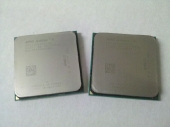 |
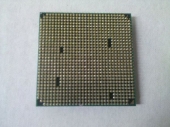 |
Athlon II VS Phenom II:
The Athlon II line of chips was released as a complement to the Phenom II line. The Athlon II is aimed at the entry/mid range while the Phenom II is aimed for the mid/high end range. Unlike some of the dual-core Phenom II’s, which were quad-core chips that were locked down, the Regor cores are native dual-core, meaning you can’t unlock any cores with them. You are stuck with the two cores you are given.
The Athlon II line of chips are also lacking an L3 cache. AMD tries to make up for this by giving the chips a larger L2 cache.
Test Rig:
- Glacialtech Altair A381 Media Center PC Case
- MSI 890GXM-G65 Motherboard
- AMD Athlon II x2 255 and 260
- 4GB Crucial Ballistx Tracer RAM
- Crucial 128GB SSD
- Windows 7 x64
CPU-Z:
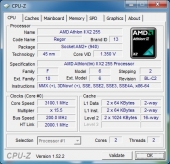 |
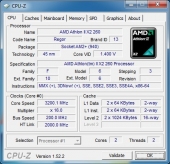 |
||
| Athlon II X2 255 | Athlon II X2 260 |
CPU-Z is a program that is used to display information about a processor, along with information about other components in the system. Here we can see that the only real difference between the chips is the multiplier (15.5x vs 16x).
Overclocking:
For our overclocking test, we went with a quick and dirty approach, by using the automated overclocking switches on the motherboard. We were able to easily get a 15% overclock on the 255, bringing it up to around 3.56 GHz. If you go in and manually overclock the chip, along with proper cooling, a 20% overclock should be achievable on either of these chips. Theoretically the 260 should overclock better as it is a “higher quality” chip. Honestly this is not always the case, it really depends on luck of the draw when it comes to chip quality and their overclocking ability. This is more of a demonstration of what may be possible.
SiSoft Sandra:
We love to use SiSoft as it provides a wide barrage of benchmarks for a particular system
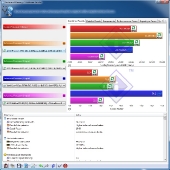 |
 |
||
| Cache and Memory – 255 | Cache and Memory – 260 |
The cache and memory test helps benchmark the on board cache of the processor. We can see that the 255 has a cache and memory bandwidth of 26.24 GB/s while the 260 weighs in at 28.36 GB/s.
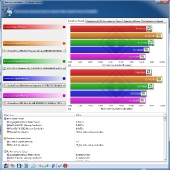 |
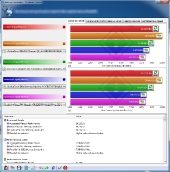 |
||
| Memory Bandwidth – 255 | Memory Bandwidth – 260 |
For the memory bandwidth benchmark, the 255 scores an aggregate memory performance of 9.45 GB/s while the 260 scores 10.22 GB/s
 |
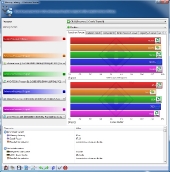 |
||
| Memory Latency – 255 | Memory Latency – 260 |
The 255 has a memory latency of 90 ns and the 260 is 82 ns. A faster chip means less latency and better performance.
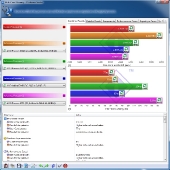 |
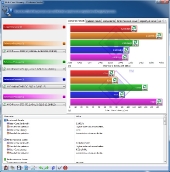 |
||
| Multi-Core Efficiency – 255 | Multi-Core Efficiency – 260 |
There isn’t too much difference in efficiency as they are almost the same chip. The 255 scores 3.1 GB/s while the 260 scores 3.24 GB/s.
 |
 |
||
| Power Management Efficiency – 255 | Power Management Efficiency – 260 |
The power management efficiency is measured in MIPS or millions of instructions per second. The 255 performs at 7642 MIPS and the 260 at 8386 MIPS.
 |
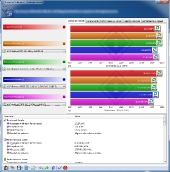 |
||
| Processor Arithmetic – 255 | Processor Arithmetic – 260 |
The processor arithmetic benchmark is used to determine how well a processor can handle arithmetic instruction. The 255 scores an aggregate performance of 19.65 GOPS while the 260 scores 20.29 GOPS.
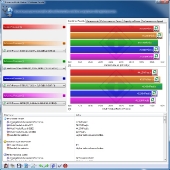 |
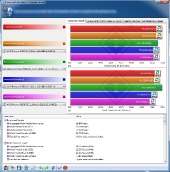 |
||
| Processor Multi-Media – 255 | Processor Multi-Media – 260 |
This benchmarks is supposed to gauge the expected performance in multimedia applications. The 255 has an aggregate performance of 57.5 MPixels/s and the 260 has 59.4 MPixels/s, owing the win the its faster clock speed.
Cinebench:
Cinebench is a programs that tests the CPU by rendering out a 3D scene and measuring how long it takes to complete the task.
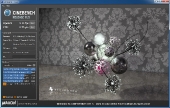 |
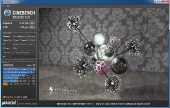 |
||
| Athlon II X2 255 | Athlon II X2 260 |
We can see that the 255 scored .75 points while the 260 scored 1.69 points. What’s also interesting is that the OpenGL score is higher in the 260’s test. The 255 may have been a slight bottleneck for the onboard Radeon 4290.
WinRAR:
The archiving program WinRAR has a built in benchmark tool to determine how quickly a a CPU can compress data.
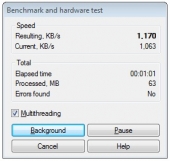 |
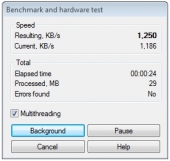 |
||
| Athlon II X2 255 | Athlon II X2 260 |
The 255 comes in at 1170 KB/s while the 260 attains 1250 KB/s, owing the victory to its slightly faster clock speed.
PC Mark Vantage:
PC Mark is made by the same creators of 3D Mark. While 3D Mark focuses more on potential gaming ability, PC Mark focuses on overall system performance.
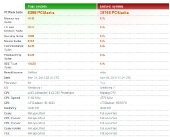 |
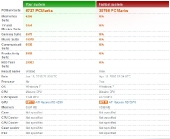 |
||
| Athlon II X2 255 | Athlon II X2 260 |
The 255 configuration scored and overall score of 6055 while the 260 scored a 6727. If you look at the sub-score of each, you can see how the change in clock speed affects all components of the test.

Summary and Conclusion:
For a budget chip, the 255 and 260 perform well. The cutting of the L3 cache is disappointing, but understandable as a means of cutting production costs. The price difference between them is only about $10 and that still puts both of them cheaper than the other Intel alternatives. The next step up would be one of the Phenom II’s. The lowest end chip in that line is still more expensive than the 260. Even though you may be able to unlock the cores on a Phenom II, it really is a blind shot in the dark as to whether or not you will be successful with it. If you’re on a seriously strict budget and want the most dual core you can get, then you can’t go wrong with either the 255 or 260. If you do want to spend a few more dollars, you can get yourself a Phenom II x2 and gamble as to whether or not you will be able to unlock any of the cores and transform it into an x3 or x4.
TechwareLabs Relevant Reviews: |
|
Additional Reviews You May Like: |
HardOCP |

it was very interesting to read http://www.techwarelabs.com
I want to quote your post in my blog. It can?
And you et an account on Twitter?